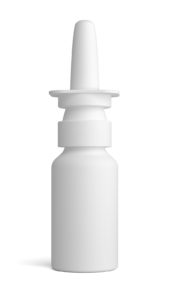
Theophylline Atomized Nasal Spray
Formulation: Theophylline 0.5% nasal spray
Theophylline intranasal can help improve sense of smell (and also sense of taste), especially due to smell dysfunction following a viral infection.
Description
Theophylline improves levels of the proteins cAMP and cGMP in the nose. Low levels of these are associated with loss of smell, often following a viral infection.
In a small study of 10 patients, 50% had an improved sense of smell after 4 weeks of intranasal theophylline therapy. In another study it was shown that intranasal theophylline was more effective at improving smell and taste than the oral form of the drug.
Theophylline is not dispensed in a solution but instead in the form of capsules which are mixed with a saline rinse for nasal spray or irrigation.
What is Theophylline?
Theophylline is a phosphodiesterase inhibitor that is similar to caffeine. It has been used for treating respiratory conditions like asthma. Recently, interest in this drug has grown for its ability to improve sense of smell. This is following the prevalence of smell dysfunction in patients who have recovered from COVID-19 infection.
Form of Theophylline
Theophylline studies for treating smell dysfunction have used either oral or intranasal forms of the drug. To date the research shows that an intranasal form is more effective and produces fewer side effects. In initial studies, there were benefits observed with intranasal as soon as one week after initiating treatment for some patients. Intranasal administration avoids first pass metabolism in the gastrointestinal system, which reduces systemic effects. Administering directly to the nasal passages also allows targeting of the affected area so lower doses can be used. There are benefits to having the drug interact directly with the olfactory epithelium.
A study that examined maximum doses of theophylline found that using up to 800mg intranasally on a daily basis produced no more side effects than lower doses. Patients experienced lightheadedness in some cases and one patient discontinued treatment, but no serious adverse effects were reported.
What Causes Loss of Smell
Alterations in sense of smell often occur following a viral infection or are associated with other disorders. These alterations in smell have been especially prevalent in patients with COVID-19. They may also occur as a result of smoking, air pollution, Parkinson’s disease, Alzheimer’s disease, or an injury.
Hyposmia – Ability to detect an odor is reduced.
Dysosmia – Sense of smell is changed. Some scents may smell different or you may notice scents that are not there.
Anosmia – Loss of sense of smell that can be total or partial.
Investigations have shown that cyclic adenosine monophosphate (cAMP) and cyclic guanosine monophosphate (cGMP) in olfactory mucosa are lower for patients with these conditions affecting sense of smell. Theophylline is a phosphodiesterase inhibitor that can be used to increase cAMP and cGMP which are thought to play an important role in sense of smell.
With loss of smell due to COVID-19 infection, most patients will experience improvement within a few weeks after recovering. Some patients however may experience smell dysfunction for 8 weeks or more after the infection. For these patients, olfactory training and treatment with theophylline may be beneficial to recover sense of smell.
Olfactory Training
Olfactory training is one of the primary ways that these smell conditions are treated. It can be effective, but is not enough for many patients. This training involves smelling particularly recognizable and strong scents on a daily basis such as rose, eucalyptus, lemon, and cloves. In one regimen, each of these scents is smelled for 10 seconds, with a 10 second interval between them. This is repeated both in the morning and at night. Other methods exist and different scents can be chosen based on what the patient responds to and what is available to them.
Articles
Intranasal Theophylline Treatment of Hyposmia and Hypogeusia: A Pilot Study – JAMA Otolaryngology
Safety of High-Dose Nasal Theophylline Irrigation in the Treatment of Postviral Olfactory Dysfunction: A Dose-Escalation Study – JAMA Otolaryngology
An open-label controlled trial of theophylline for treatment of patients with hyposmia – American journal of the medical sciences
Order Theophylline Nasal Spray
Question about intranasal theophylline? Reach out to us today:
Related Articles
- Low Dose Naltrexone for Crohn’s Disease
 Crohn’s is a chronic inflammatory condition of the gastrointestinal tract with no known cure. Treatments exist to manage symptoms and… Read more: Low Dose Naltrexone for Crohn’s Disease
Crohn’s is a chronic inflammatory condition of the gastrointestinal tract with no known cure. Treatments exist to manage symptoms and… Read more: Low Dose Naltrexone for Crohn’s Disease - Jessner’s Peels – What Are They and What’s the Hype?
 While there always seems to be hype about Jessner’s peels they actually have been around for a long time compared… Read more: Jessner’s Peels – What Are They and What’s the Hype?
While there always seems to be hype about Jessner’s peels they actually have been around for a long time compared… Read more: Jessner’s Peels – What Are They and What’s the Hype? - Butyrate – Nourishing Gut Bacteria to Improve Health
 A gastroenterologist with the University of Washington School of Medicine studies the way that what you eat affects the gut… Read more: Butyrate – Nourishing Gut Bacteria to Improve Health
A gastroenterologist with the University of Washington School of Medicine studies the way that what you eat affects the gut… Read more: Butyrate – Nourishing Gut Bacteria to Improve Health



